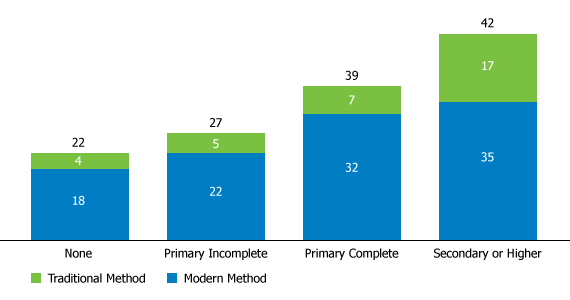
Fertility and Infant Mortality Declines in Tanzania
(December 2010) Tanzania is one of the world’s poorest countries, with a 2008 annual per capita income of just $1,263, and nearly 90 percent of the population living on less than $1.25 per day.1 Maternal, infant, and childhood mortality—important indicators of overall socioeconomic conditions—are high, even for East Africa. But results from the Tanzania 2010 Demographic and Health Survey (DHS) show considerable improvement in infant and child mortality and a modest decline in fertility.2 Some maternal health indicators show progress as well.
Between 1992 and 1996, about 88 of every 1,000 newborns died before their first birthday, and 137 of every 1,000 died before age 5. The 2010 DHS found the average infant mortality rate had dropped to 51 per 1,000—and the under-5 mortality rate to 81—in the five years preceding the survey. There are other clear, if less dramatic, signs that health has improved for women and children. There have been modest increases since the mid-2000s in the percentage of expectant mothers receiving prenatal care, injections against tetanus, and vitamin A supplements (which can prevent blindness). The vast majority see a medical professional at least once during their pregnancy. Although four visits are recommended, one visit means that most pregnant women are at least interacting with the health care system.
However, only 50 percent of Tanzanian mothers have the services of a skilled attendant during childbirth. While this is a slight increase from 46 percent in the 2004-05 DHS, it is not enough progress to significantly improve maternal health and reduce maternal mortality. Skilled medical care during childbirth reduces the risk of infection and other complications that threaten the health of both mother and child.
There is considerable variation in who uses skilled childbirth attendants. Mothers who are younger, have more education, and who live in urban areas are much more likely to have received medical care from a skilled attendant at childbirth. The DHS found that mothers with at least a secondary education were twice as likely to have skilled childbirth attendants than women with no education.
While the most recent estimates from the World Health Organization (WHO) show some improvement in maternal mortality in Tanzania, the WHO labeled it as “insufficient progress.”3 Although the ratio of pregnancy-related deaths fell from about 920 women per 100,000 births to 790 women per 100,000 between 2000 and 2008, Tanzania’s maternal mortality remains above the average for eastern and southern Africa (550 maternal deaths per 100,000 births in 2008).
Mothers Having Fewer Children
High maternal mortality usually goes hand-in-hand with high fertility, and Tanzanian women have a history of large families. In the early 1990s, Tanzanian women had about 6.3 children each, on average. Fertility has generally declined since then, with some fluctuations. The 2010 survey recorded the lowest level yet—5.4 lifetime births per woman—but it is too soon to tell whether this signals a sustained decline.
Fertility varies substantially among different groups of women. Women living on Tanzania’s large island of Zanzibar have about 5.1 children each. On the mainland, rural women have much larger families than urban women: 6.1 children compared with 3.7 children, respectively.
Family Planning Use Increases
Family planning use has increased among married women in Tanzania since the early 1990s and has played an important role in fertility decline. But family planning use is still relatively low in the country, rising from 10 percent in the early 1990s to 34 percent in 2010. Most women opt for modern contraceptive methods, especially injectable hormones and oral contraceptives. Family planning use is much higher among more-educated women. One-half of married women ages 15 to 49 with at least some secondary education were using a contraceptive method at the time of the DHS, compared with just 22 percent of similar women with no education (see figure). Similarly, contraceptive use is higher in urban areas (45 percent) than in rural areas (30 percent).
Percent of Married Women Using a Contraceptive Method by Education in Tanzania, 2010

Source: Tanzania Bureau of Statistics and ICF Macro, Tanzania 2010 Demographic and Health Survey: Preliminary Report (Calverton, MD: ICF Macro, 2010).
Family Planning to Reduce Maternal and Child Mortality
Increased family planning use can also help reduce Tanzania’s high maternal mortality. Research has demonstrated that family planning can prevent up to one in every three maternal deaths by allowing women to avoid high-risk pregnancies and abortion of unintended pregnancies.4 When women can wait at least two years between pregnancies, their children are healthier, reducing infant and child mortality. The 2010 DHS indicates continued increase in the use of effective contraceptive methods, which can help Tanzania improve the health of mothers and children and ease the burden of widespread poverty.
Mary Mederios Kent is a senior demographic writer at the Population Reference Bureau.
References
- Population Reference Bureau, DataFinder: Tanzania, accessed at www.prb.org/Datafinder.aspx, on Nov. 10, 2010; and United Nations Population Fund and Population Reference Bureau, Country Profiles for Population and Reproductive Health: Policy Developments and Indicators: 2009/2010 (Tanzania), accessed at www.prb.orghttps://www.prb.org/wp-content/uploads/2010/12/unfpacountryprofiles.pdf, on Nov. 10, 2010.
- Tanzania National Bureau of Statistics and ICF Macro, Tanzania 2010 Demographic and Health Survey: Preliminary Report (Calverton, MD: ICF Macro, 2010); and Tanzania Bureau of Statistics and Macro International, Tanzania Demographic and Health Survey 1996 (Calverton, MD: Bureau of Statistics and Macro International, 1997).
- World Health Organization (WHO) et al., Trends in Maternal Mortality: 1990 to 2008 (Geneva: WHO, UNICEF, UNFPA, and The World Bank, 2010), accessed at http://whqlibdoc.who.int/publications/2010/9789241500265_eng.pdf, on Nov. 10, 2010.
- Rhonda Smith et al., Family Planning Saves Lives, 4th ed. (Washington, DC: Population Reference Bureau, 2009).
